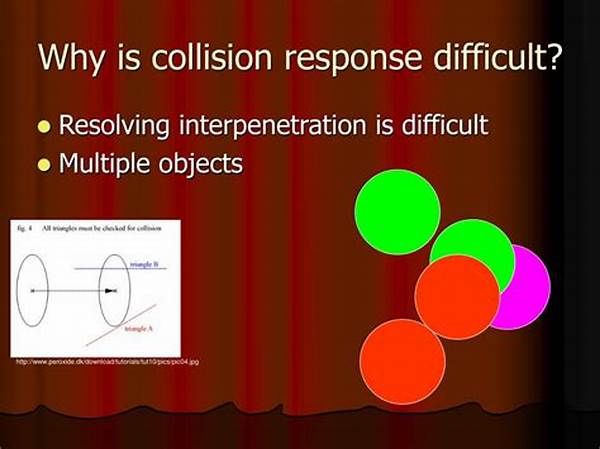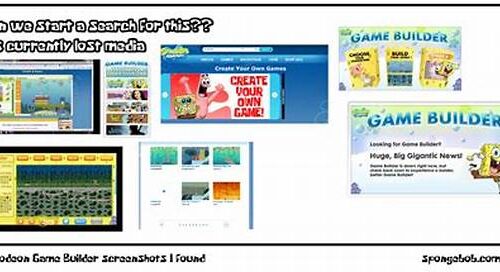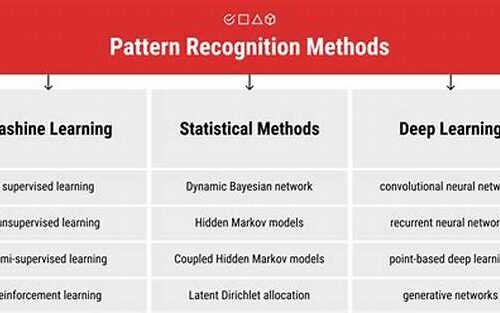Hey there, gaming enthusiasts and curious minds! Today, let’s dive into a topic that’s the backbone of the gaming world and a crucial element for many tech applications: collision detection and response. Whether you’re designing the next big hit game or tinkering with simulations, understanding this concept is an absolute must. Ready to unravel this fascinating topic? Let’s go!
Read Now : Simulation Of Natural Physical Interactions
Understanding Collision Detection and Response
Alright, let’s break it down. Collision detection and response is all about figuring out when objects in a digital space collide and then determining what happens after that collision. Imagine playing your favorite video game. You don’t want your character to just walk through walls, right? That’s where collision detection comes in to save the day. It identifies when your character hits the wall. But detecting the collision is just half the battle; what happens after the detection? That’s the response part. Your character might bounce back, take damage, or perform a special move, depending on the game mechanics. This combination of detecting and responding to collisions ensures a realistic and immersive experience, making our games more engaging and believable. Whether it’s a pixelated platformer or a sophisticated 3D adventure, collision detection and response is what keeps the virtual world as enthralling as the real one.
Key Concepts in Collision Detection and Response
1. Bounding Boxes: Often used for simplicity, bounding boxes help detect potential collisions in collision detection and response scenarios. They wrap around objects in rectangular shapes to simplify calculations.
2. Pixel Perfect Collision: For those who crave precision, this method involves checking collisions at the pixel level, usually used in 2D games for accuracy.
3. Physics Engines: Leveraging physics engines helps execute realistic collision detection and response, simulating physics laws in gaming environments.
4. Event Triggering: Upon collision detection, the response is often triggered as an event that alters game behavior—be it a sound, a visual effect, or a logical state change.
5. Game AI Enhancement: Collision detection and response play an essential role in enhancing game AI, allowing non-player characters to react intelligently to environments.
Practical Applications of Collision Detection and Response
Now, you might be wondering, where else do we see collision detection and response beyond games? Think robotics and simulations. When a robot is moving through a space, you don’t want it crashing into every obstacle. Here, collision detection helps identify potential crashes, and the response ensures the robot navigates smoothly, possibly even learning from its environment. Then we have virtual and augmented reality. These technologies rely heavily on collision detection and response to create immersive experiences. Imagine donning a VR headset and exploring a new world. You’ll want interactions with the environment to feel natural and responsive, and that’s exactly what this technology provides. So, whether it’s gaming, robotics, VR, or beyond, collision detection and response play a crucial role in how effectively digital and real-world interactions are managed.
Read Now : Wireless Microphone System Setup
Challenges in Collision Detection and Response
Working with collision detection and response does come with its challenges, though. Firstly, computational complexity can be intense. As the number of objects increases, the calculations for detecting and responding to collisions become more complex and resource-consuming. Next, there’s accuracy versus performance. Striking a balance between precise collision detection and maintaining optimal performance is tricky, especially in fast-paced games or simulations. Furthermore, resolving ambiguous responses can be a headache when multiple collisions occur simultaneously. Developers need to plan meticulously to ensure that neither performance is compromised nor the intended user experience. Understanding these challenges can lead to more informed decisions when implementing collision detection and response systems in your own projects.
The Future of Collision Detection and Response
As technology advances, the field of collision detection and response is also evolving. Machine learning and AI are starting to be integrated into these systems, making them smarter and more adaptive. This is particularly exciting because it means future applications could predict potential collisions and adjust responses dynamically, enhancing immersion and realism. Another promising area is the application of quantum computing, which could revolutionize the computational efficiency of collision detection and response. Imagine a digital world where responses are fluid, reactive, and nearly indistinguishable from reality. The future indeed holds endless possibilities for this intriguing technology, sparking innovations across gaming, robotics, digital simulations, and more.
Wrapping It Up: Collision Detection and Response
To sum it all up, collision detection and response is a foundational concept not just in gaming but in various tech fields. It ensures our digital interactions are believable, engaging, and aligned with real-world physics. The journey from a simple collision detection to crafting an intricate response involves understanding key concepts, tackling challenges, and embracing future advancements. As you explore this area further, whether for professional projects or personal inquisitions, remember that every collision and response contributes to a more immersive digital narrative. Who knew that understanding how virtual objects collide could be so exciting and hold so much potential? So, keep experimenting and pushing the boundaries of what’s possible. The future is colliding with endless possibilities!
Final Thoughts on Collision Detection and Response
If you’ve made it this far, congrats! You’re well on your way to mastering collision detection and response. It’s a vast and dynamic field, offering so many opportunities for creativity and innovation. Whether you’re coding the next blockbuster game or working on cutting-edge simulations, this knowledge is your toolkit for success. Keep exploring and experimenting. Who knows what groundbreaking applications you might develop or what fascinating collisions you’ll orchestrate? So, go on and make those digital worlds even more extraordinary. Happy coding and colliding!




